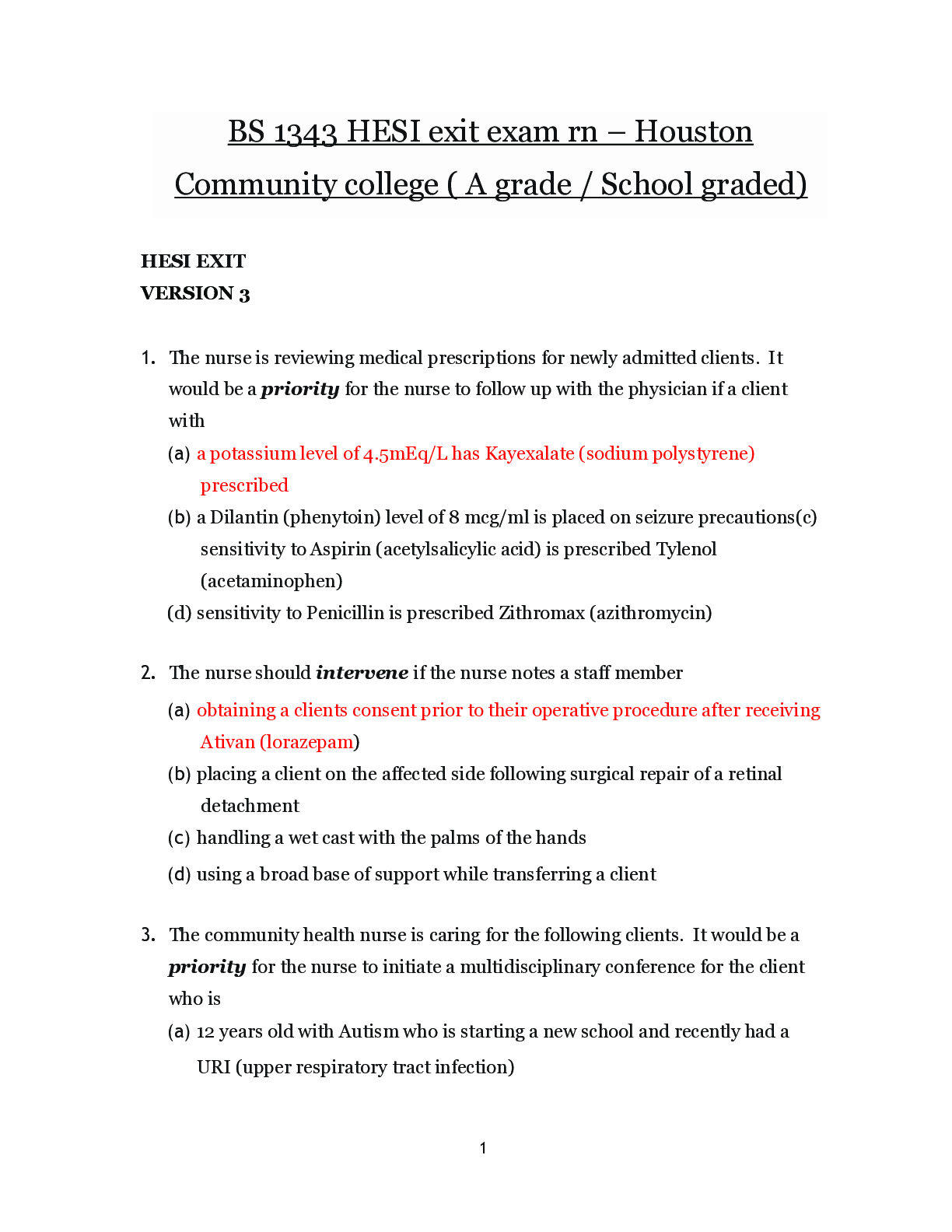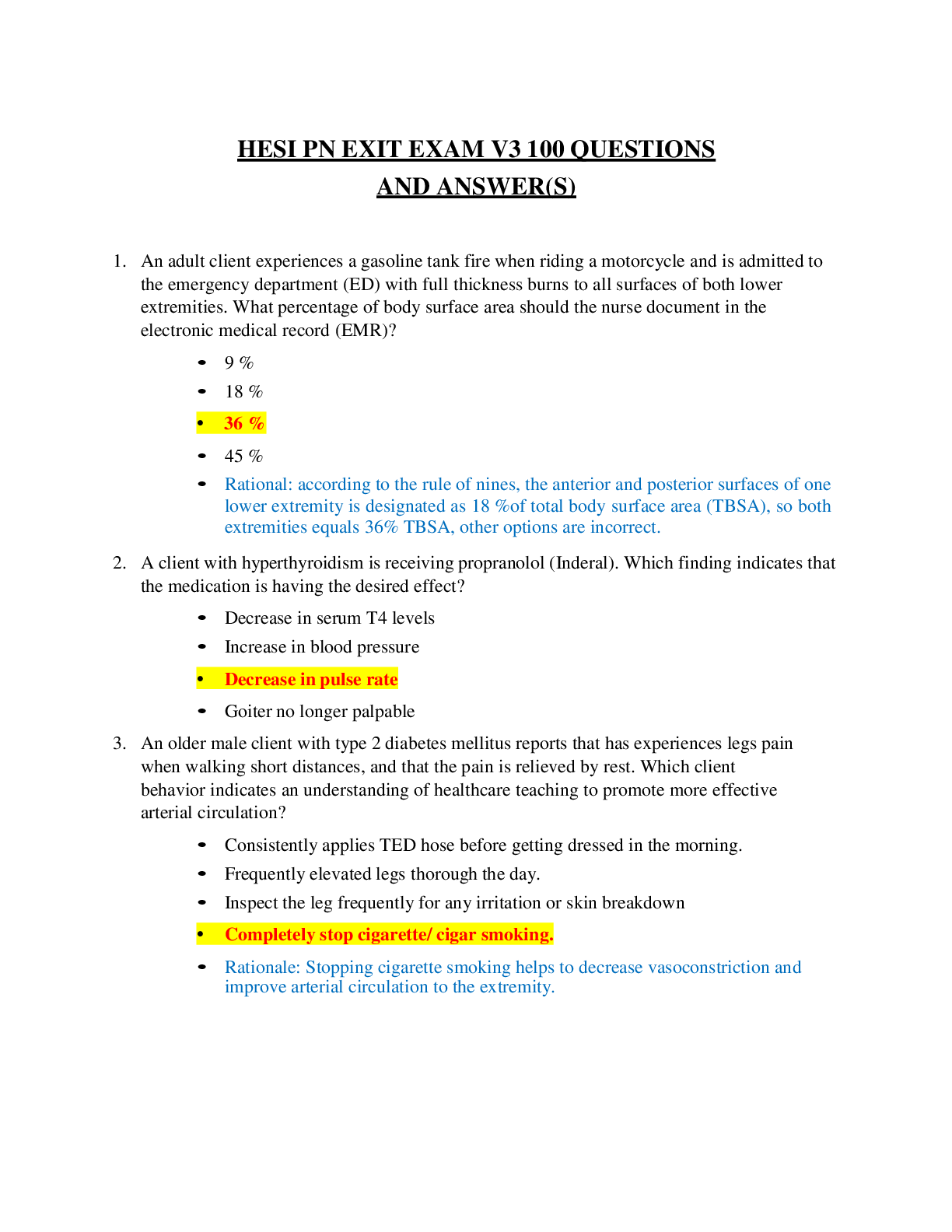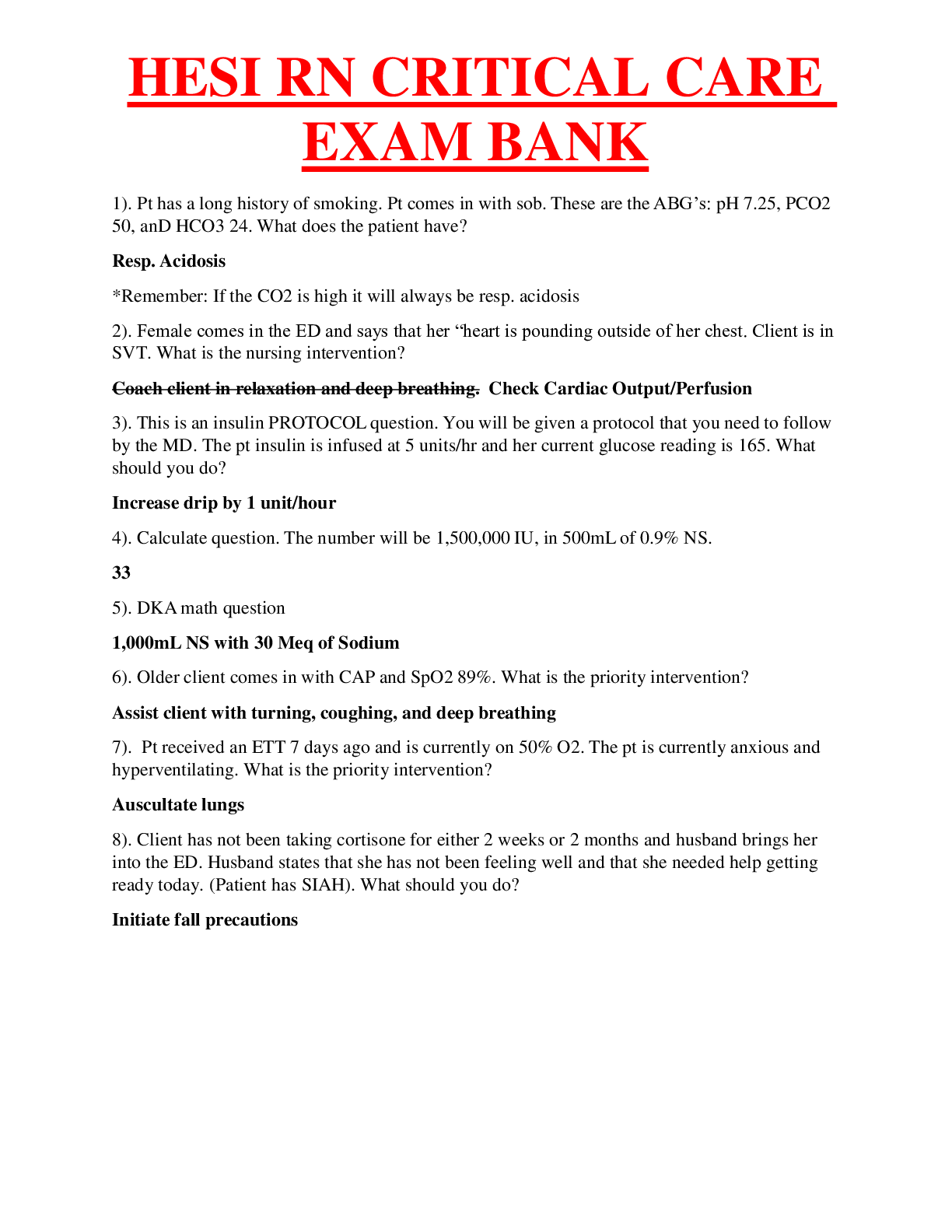Hesi Practice Test- Evolve. Questions and accuarate answers. Graded A+
Document Content and Description Below
Hesi Practice Test- Evolve. Questions and accuarate answers. Graded A+ The nurse is administering medications through a nasogastric tube (NGT) which is connected to suction. After ensuring correct ... tube placement, what action should the nurse take next? A. Clamp the tube for 20 minutes. B. Flush the tube with water. C. Administer the medications as prescribed. D. Crush the tablets and dissolve in sterile water. - The NGT should be flushed before, after and in between each medication administered (B). Once all medications are administered, the NGT should be clamped for 20 minutes (A). (C and D) may be implemented only after the tubing has been flushed. Correct Answer: B What is the most important reason for starting intravenous infusions in the upper extremities rather than the lower extremities of adults? A. It is more difficult to find a superficial vein in the feet and ankles. B. A decreased flow rate could result in the formation of a thrombosis. C. A cannulated extremity is more difficult to move when the leg or foot is used. D. Veins are located deep in the feet and ankles, resulting in a more painful procedure. - Venous return is usually better in the upper extremities. Cannulation of the veins in the lower extremities increases the risk of thrombus formation (B) which, if dislodged, could be life-threatening. Superficial veins are often very easy (A) to find in the feet and legs. Handling a leg or foot with an IV (C) is probably not any more difficult than handling an arm or hand. Even if the nurse did believe moving a cannulated leg was more difficult, this is not the most important reason for using the upper extremities. Pain (D) is not a consideration. Correct Answer: B A client is to receive cimetidine (Tagamet) 300 mg q6h IVPB. The preparation arrives from the pharmacy diluted in 50 ml of 0.9% NaCl. The nurse plans to administer the IVPB dose over 20 minutes. For how many ml/hr should the infusion pump be set to deliver the secondary infusion? - The infusion rate is calculated as a ratio proportion problem, i.e., 50 ml/ 20 min : x ml/ 60 min. Multiply extremes and means 50 × 60 /20x 1= 300/20=150 Correct Answer: 150The nurse mixes 50 mg of Nipride in 250 ml of D5W and plans to administer the solution at a rate of 5 mcg/kg/min to a client weighing 182 pounds. Using a drip factor of 60 gtt/ml, how many drops per minute should the client receive? A. 31 gtt/min. B. 62 gtt/min. C. 93 gtt/min. D. 124 gtt/min. - (D) is the correct calculation: Convert lbs to kg: 182/2.2 = 82.73 kg. Determine the dosage for this client: 5 mcg × 82.73 = 413.65 mcg/min. Determine how many mcg are contained in 1 ml: 250/50,000 mcg = 200 mcg per ml. The client is to receive 413.65 mcg/min, and there are 200 mcg/ml; so the client is to receive 2.07ml per minute. With a drip factor of 60 gtt/ml, then 60 × 2.07 = 124.28 gtt/min (D) OR, using dimensional analysis: gtt/min = 60 gtt/ml X 250 ml/50 mg X 1 mg/1,000 mcg X 5 mcg/kg/min X 1 kg/2.2 lbs X 182 lbs. Correct Answer: D A client is to receive 10 mEq of KCl diluted in 250 ml of normal saline over 4 hours. At what rate should the nurse set the client's intravenous infusion pump? A. 13 ml/hour. B. 63 ml/hour. C. 80 ml/hour. D. 125 ml/hour. - (B) is the correct calculation: To calculate this problem correctly, remember that the dose of KCl is not used in the calculation. 250 ml/4 hours = 63 ml/hour. Correct Answer: B The healthcare provider prescribes the diuretic metolazone (Zaroxolyn) 7.5 mg PO. Zaroxolyn is available in 5 mg tablets. How much should the nurse plan to administer? A. ½ tablet. B. 1 tablet. C. 1½ tablets. D. 2 tablets. - (C) is the correct calculation: D/H × Q = 7.5/5 × 1 tablet = 1½ tablets. Correct Answer: CHeparin 20,000 units in 500 ml D5W at 50 ml/hour has been infusing for 5½ hours. How much heparin has the client received? A. 11,000 units. B. 13,000 units. C. 15,000 units. D. 17,000 units. - (A) is the correct calculation: 20,000 units/500 ml = 40 units (the amount of units in one ml of fluid). 40 units/ml x 50 ml/hr = 2,000 units/hour (1,000 units in 1/2 hour). 5.5 x 2,000 = 11,000 (A). OR, multiply 5 x 2,000 and add the 1/2 hour amount of 1,000 to reach the same conclusion = 11,000 units. Correct Answer: A The nurse prepares a 1,000 ml IV of 5% dextrose and water to be infused over 8 hours. The infusion set delivers 10 drops per milliliter. The nurse should regulate the IV to administer approximately how many drops per minute? A. 80 B. 8 C. 21 D. 25 - The accepted formula for figuring drops per minute is: amount to be infused in one hour × drop factor/time for infusion (min)= drops per minute. Using this formula: 1,000/8 hours = 125 ml/ hour 125 × 10 (drip factor) = 1,250 drops in one hour. 1,250/ 60 (number of minutes in one hour) = 20.8 or 21 gtt/min (C). Correct Answer: C A client's infusion of normal saline infiltrated earlier today, and approximately 500 ml of saline infused into the subcutaneous tissue. The client is now complaining of excruciating arm pain and demanding "stronger pain medications." What initial action is most important for the nurse to take? A. Ask about any past history of drug abuse or addiction. B. Measure the pulse volume and capillary refill distal to the infiltration. C. Compress the infiltrated tissue to measure the degree of edema. D. Evaluate the extent of ecchymosis over the forearm area. - Pain and diminished pulse volume (B) are signs of compartment syndrome, which can progress to complete loss of the peripheral pulse in the extremity. Compartment syndrome occurs when external pressure (usually from a cast), or internal pressure (usually from subcutaneous infused fluid), exceeds capillary perfusion pressure resulting in decreased blood flow to the extremity. (A) should not be pursued until physical causes of the pain areruled out. (C) is of less priority than determining the effects of the edema on circulation and nerve function. Further assessment of the client's ecchymosis can be delayed until the signs of edema and compression that suggest compartment syndrome have been examined (D). Correct Answer: B A client with acute hemorrhagic anemia is to receive four units of packed RBCs (red blood cells) as rapidly as possible. Which intervention is most important for the nurse to implement? A. Obtain the pre-transfusion hemoglobin level. B. Prime the tubing and prepare a blood pump set-up. C. Monitor vital signs q15 minutes for the first hour. D. Ensure the accuracy of the blood type match. - All interventions should be implemented prior to administering blood, but (D) has the highest priority. Any time blood is administered, the nurse should ensure the accuracy of the blood type match in order to prevent a possible hemolytic reaction. Correct Answer: D The healthcare provider prescribes 1,000 ml of Ringer's Lactate with 30 Units of Pitocin to run in over 4 hours for a client who has just delivered a 10 pound infant by cesarean section. The tubing has been changed to a 20 gtt/ml administration set. The nurse plans to set the flow rate at how many gtt/min? A. 42 gtt/min. B. 83 gtt/min. C. 125 gtt/min. D. 250 gtt/min. - gtt/min = 20gtts/ml X 1000 ml/4hrs X 1 hr/60 min Correct Answer: B The nurse is caring for a client who is receiving 24-hour total parenteral nutrition (TPN) via a central line at 54 ml/hr. When initially assessing the client, the nurse notes that the TPN solution has run out and the next TPN solution is not available. What immediate action should the nurse take? A. Infuse normal saline at a keep vein open rate. B. Discontinue the IV and flush the port with heparin. C. Infuse 10 percent dextrose and water at 54 ml/hr. D. Obtain a stat blood glucose level and notify the healthcare provider. - TPN is discontinued gradually to allow the client to adjust to decreased levels of glucose. Administering 10% dextrose in water at the prescribed rate (C) will keep the client from experiencing hypoglycemia until the next TPN solution isavailable. The client could experience a hypoglycemic reaction if the current level of glucose (A) is not maintained or if the TPN is discontinued abruptly (B). There is no reason to obtain a stat blood glucose level (D) and the healthcare provider cannot do anything about this situation. Correct Answer: C [Show More]
Last updated: 2 years ago
Preview 1 out of 6 pages

Buy this document to get the full access instantly
Instant Download Access after purchase
Buy NowInstant download
We Accept:

Reviews( 0 )
$12.00
Can't find what you want? Try our AI powered Search
Document information
Connected school, study & course
About the document
Uploaded On
May 13, 2022
Number of pages
6
Written in
Additional information
This document has been written for:
Uploaded
May 13, 2022
Downloads
0
Views
96














